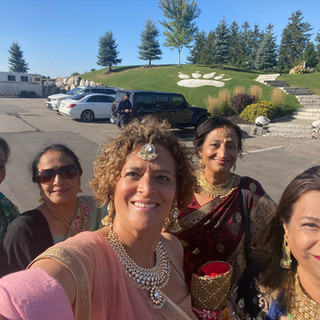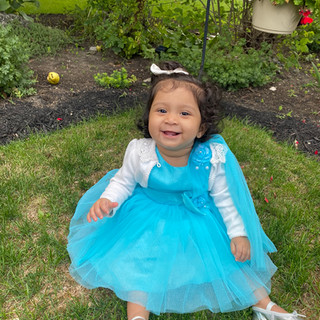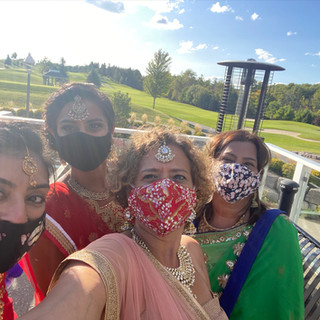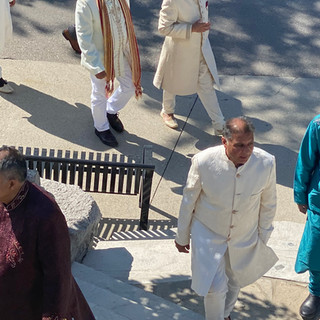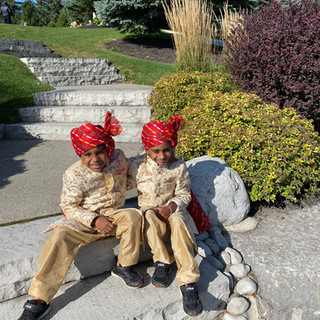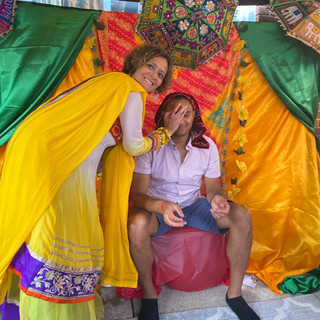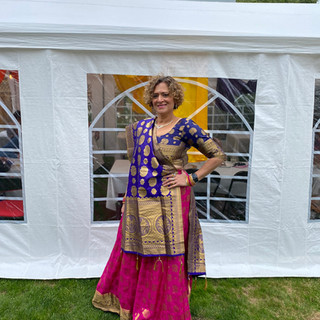My nephew’s COVID wedding! One thing about Indian weddings is that they are not dull nor boring. COVID may of delayed the wedding day and minimized the celebrations as number of guests was limited (500 to 50) but it didnot stop us from having fun. Only immediate family was present and guest wore masks as needed and stayed in their own bubble. Weather was beautiful, the bride and groom looked gorgeous!
Indian weddings are traditionally multi-day affairs, and involve many intricate ceremonies, such as the painting of the hands and feet of the bride called a mehndi. The Indian weddings are full of tradition that reflect our hindu punjabi culture with rituals, songs, dance, food, and dress that has evolved for centuries. They are typically divided into three parts: pre-wedding, main , and post-wedding celebrations.
PRE-WEDDING CELEBRATIONS
Ladies Sangeet Ceremony

The word Sangeet translates to 'sung together' from Sanskrit. 'Gaun', another word used to describe the event, means 'songs' or 'to sing' in Hindi. In the old days the Sangeet could last anywhere from 8 to 10 days, celebrating up until the wedding day. Over time this tradition was cut down to a one day function in order to fit all of the wedding events into one week. The ceremony takes place two or three days before the actual the wedding. This celebration includes dances performed by relatives and friends of the Bride and Groom, songs by the elder female members of the family sung in unison with the bride as the focal point, and an open dance floor to commemorate the festivities for the following days. Party gets a bit crazy as the songs include ‘jokes’ about in-laws, bride leaving her parents’ home, and on how to have a successful marriage. The event is usually initiated by the bride’s side of the family where her family welcomes the groom’s family by singing Suhaag, a traditional songs, to the tune of the DHOL (drums). Due to COVID we had the celebrations separately. The Groom’s (my nephew) sangeet was at my sister’s house but no less fun! Indians love to party!

Jaago ceremony meaning is “staying awake”. The Jaago ritual involves the relatives of the groom and bride, in their own homes. The idea is to celebrate the wedding by dancing and partying all night. In the Jaggo ceremony, family and friends dance and sings on the road in front and around the beautifully decorated wedding home. Copper vessels called "gaffers" are decorated with divas (clay lamps), filled with mustard oil, and lit. The bride/bridegroom's maternal aunt (mammi) carries it on her head, and another lady carries a long stick with bells, which she shakes. The ladies then go into other friends' and families' homes to be welcomed with sweets and drinks. It’a a ceremony filled with joy, dancing, fireworks, and food. Of course COVID changed that as we were not able to go to other friends’ and families’ homes but fun was had by all regardless.

Mehendi is one of the oldest forms of body art conceived by man. The Hindi and Arabic word Mehendi is derived from a Sanskrit word ‘mendhika’ which referred to the henna plant itself. Mehendi ceremony has become such an integral part of the wedding ceremony that wedding functions cannot be imagined without it. The Mehendi Ceremony usually takes place the day or two before the wedding. The bride and the groom’s family observe this ritual separately in their own homes. It is traditionally a women ceremony with the men of the family generally not participating (exceptions have been made..lol). The venues are decked up with flowers and colorful draperies. It is not compulsory for the groom to get Mehendi applied, but a little bit is applied on his hands and feet in simple dots or small designs. Women of the house assemble and the Mehndi is either applied by one of the bride’s relative or nowadays by professional Mehendi artists. Designs are more elaborate and depending on what the bride prefers, the henna is applied on the front and back of her palm, forearm, till above the elbows, and on the feet till below the knee. Elderly ladies sing traditional Mehendi songs with dholaks and other musical instruments. Women relatives of the bride and groom also get Mehendi applied to their hands, although the designs are not as elaborate as the bridal Mehendi. The night will involve loads of dancing, singing, eating and drinking.


Maiyan (Maiya) ceremony. Is the countdown for “THE BIG DAY”. Traditionally, Maiyan (Maiya) is conducted three times, which starts two days before the wedding day, when it's customary to start before midday. The ceremony is performed at the couple's respective homes. The prospective bride or groom is seated on a wooden plank called a patri, and a red cloth is held above by four female relatives, while married women of the household and biradari, led by the mother, rub a paste of turmeric, flour and mustard oil on his or her face, arms and legs. During the ritual women sing traditional songs and those of the biradari receive the ritual gift of gogley (Punjabi sweets specially cooked for weddings) at the end of the ceremony. Bride and the Groom cannot leave their respective homes after this ceremony.

Sehra: Like the bride's home, the Vatna and Ghara Gharoli are followed by the dressing up of the groom in his wedding attire. After the groom has dressed up in his wedding clothes, a puja is performed. Thereafter, the groom's sisters ties the sehra on the groom's head. After the completion of Sehrabandi ceremony, all those who witness the function give gifts and cash to the groom as a token of good luck.

Sarbala: A young nephew or cousin dons the same attire as the groom. He is called the sarbala/shabbala (caretaker of the groom) and accompanies him. Joke is that if anything happens to the groom or changes his mind the bride will marry the Sarbala(usual age of the Sarbala is under 10..go figure!)

Ghodi Chadna is the final ceremony at the groom's place. The groom's sisters and cousins feed and adorn his mare. To ward off the evil eye, people use cash and perform the Varna ritual. The cash is then distributed among the poor. After this the boy climbs the horse and leaves his home for the wedding venue.

Varna is a ceremony that is to ward off the evil eye. The groom's bhabi lines his eyes with surma (kohl).

Joota chupai literally means 'hiding the shoes'. The bride's sisters indulge in stealing the grooms shoes. It is a fun tradition, in which the girls charge a fee for agreeing to return the shoes. They demand Kalecharis of gold for the bride's sisters and of silver for her cousins.
MAIN - WEDDING CEREMONY

7 STEPS- each symbolizing the seven joint pledges the bride and groom make to each other.
FIRST PHERA – PRAYER FOR FOOD AND NOURISHMENTS
“With God as our guide, let us take the first step to live with honor and respect. Let us walk together so we get food” The first stage of the Saat Phera, the couple prays that the Hindu deities provide them with food that nourishes the couple so that they can live together with respect and honor for one another.
SECOND PHERA – STRENGTH
“Let us be happy and enjoy life. Let us walk together so we grow together in strength,” The couple pledge to grow as one in mental, physical and spiritual strengths so that they can enjoy and share their life together.
THIRD PHERA – PROSPERITY
“Let us share joys and pains together. Let us walk together so we get wealth.” At this stage of the vows, the couple promises to earn an honest living so that they can live comfortably. Both bride and groom promises to stay faithful to each other and respect one another
FOURTH PHERA – FAMILY
“Let us not forget parents and elders. Let us walk together so we get happiness by sharing our joys and sorrows,” In this phera, the couple promises to take care of their elders to maintain a strong family relationship.
FIFTH PHERA – PROGENY
“Let us observe all acts of charity. Let us walk together so we have family” The fifth vow the couple make is to be blessed with healthy children who are kind and courageous and that the bride and groom will fulfill and provide all aspects of their childrens lives with education, love and care as well as values of live.
SIXTH PHERA – HEALTH
“Let us live a long and peaceful life. Let us walk together so we have joy” With the sixth vow, the couple pray that neither of them will suffer from ill health and that their future is calm and balanced together.
SEVENTH PHERA -
“Let us be friends with love and sacrifice. Let us walk together so we have friendship” In the final step of the Saat Phere, the couple promise to live a life of love, friendship and mutual trust. The Saat Phere makes the marriage eternal and the couple are now officially husband and wife.
In Indian weddings, the Mangala Sutra (scared necklace) is tied around the bride’s neck instead of exchanging rings. The mangala sutra is a cord with two gold pendants and is tied in three knots by the groom to symbolize the bonding of the two souls for 100 years. This necklace lets others know that the bride is married.
POST WEDDING EVENTS

After the wedding the groom and bride will go to the groom house. The couple are welcomed in a ceremony called the pani bharna. The bride must, with her right foot, kick the sarson ka tel (mustard oil) that is put on the sides of the entrance door before she enters the house. They will get elders blessing and continue the tradition of playing a fun game called Aeki Beki. A tray of water is mixed with milk and sindoor (vermillion) and it is filled with coins and a ring. Whoever finds the ring four out of seven times will rule the household. The day is then concluded with prayers to God requesting happiness and love for the newlyweds.


AND THEN WE ALL GO ON DIETS AND GET CAUGHT UP ON OUR SLEEP!!
I've added some pictures from the wedding!
Amit and Deepika you guys did an amazing job with the family social distancing COVID wedding! Congratulations and wishing you both life full of happiness! God Bless!
Love you both!




